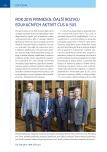SEVEN YEARS EXPERIENCES WITH APLICATION OF SHOCK WAVES TO MEN WITH PEYRONIE‘S DISEASE
Authors:
Pavel Drlík; Jiří Kočárek
Authors‘ workplace:
Urologické oddělení ÚVN Praha VoFN Praha
Published in:
Ces Urol 2015; 19(4): 296-303
Category:
Original Articles
Overview
Retrospective evaluation of shock wave therapy (ESWT) results in 81 patients with Peyronie´s disease after unsuccessful conservative treatment. ESWT was performed using electrohydraulic lithotriptor MEDILIT 7.
Aim:
Authors retrospectively evaluate results of extracorporal shock waves therapy (ESWT) in 81 patients with Peyronie´s disease after unsuccessful conservative treatment.
Methods:
In a group of 81 men with an average age of 57.6 years (33–75 years) with induratio penis plastica (Peyronie’s disease) we applied shock waves into the fibrous sheets. All patients had failed conservative treatment. The length of illness was an average of 21.4 months (12–37 months). The criteria for inclusion in the group were disease lasting at least 12 months. All patients had plaque on the dorsum of the penis root and a deformed penis. All men felt subjective symptoms during sexual intercourse. These difficulties were evaluated using the IIEF-5 questionnaire, which scored an average 11.7 points (3–17 points) prior to treatment. The size of the plaque was approximately 12.5 mm (12–37 mm), dorsal angulation during erection averaged 55 degrees (20–90 degrees). Shock waves were applied in three sessions. ESWT was performed using the electrohydraulic lithotriptor MEDILIT 7.
Results:
From the group of 81 patients an improvement was observed in 56 men. Deviation during erection improved by an average of 66 %. The size of plaque was reduced by 28.2 %. IIEF-5 questionnaire score increased by 67 %. All patients had satisfactory improvement of sexual intercourse. We recorded no serious complications.
Conclusion:
According to our seven year experience this is a safe, non-invasive method which can improve the sexual life of a proportion of patients who had previously failed conservative therapy. As a prognostic factor for treatment success in our group seems to be the age of the patient.
KEY WORDS:
Peyronie´s disease, shockwave, dorsal angulation, plaque size, IIEF-5 questionnaire.
Sources
1. Muller A, Akin-Olugbade Y, Deveci S, et al. The Impact of Shock Wave Therapy at Varied Energy and Dose Levels on Functional and Structural Changes in Erectile Tissue. Eur Urol 2008, 53: 635–643.
2. La Peyronie F. Sur quelques obstacles qui s´opposent á l´ejaculation naturele de la semence. Mem Acad Royale Chir 1743; 1: 337–342.
3. Van de Water L. Mechanisms by which fibrin and fibronectin appear in healing wounds: implications for Peyronie´s disease. J Urol 1997; 157: 306–310.
4. Devine CJ. Introduction to Peyronie´s Disease. J Urol 1997; 157: 272–275.
5. Williams G, Green NA. The non-surgical treatment of Peyronie´s disease. Br J Urol 1980, 52: 392–395.
6. Yaschia D. Corporal plication for surgical of Peyronie´s disease. J Urol 1993; 149: 869.
7. Levine LA. Review of current nonsurgical management of Peyronie´s disease. Int J Import Res 2003; 15: 113–120.
8. Hauck EW, Altinkilic BM, Ludwig M, et al. Extracorporeal shock wave therapy in the treatment of Peyronie ´s disease. First results of a case-controlled approach. Eur Urol 2000; 38: 663–669.
9. Hatzichristodoulou G, Meisner C, et al. Efficasy of extracorporeal shock wave therapy on plaque size and sexual function in patiens with Peyronie´s disease – results of a prospective, randomized, placebo-controlled study. Annual meeting of the Američan urological Association, 2007.
10. Abdel-Salam Y, Budair Z, Renner C, et al. Treatment of Peyronie´disease by extracorporeal shockwave therapy: evaluation of our preliminary results. J Endourol 1999; 13: 549–552.
11. Srirangam SJ, Manikandan R, Hussain J, et al. Long-term results of extracorporeal shockwave therapy. J Endourol 2006; 20: 880–884.
12. Skolarikos A, Alargof E, et al. Shockwave therapy as first-line treatment for Peyronie´s disease: a prospective study. J Endourol 2005; 19: 11–14.
13. Lebret T, Loison G, Hervé JM, et al. Extracorporeal shock wave therapy in the fragment of Peyronie´s disease: experience with standart lithotriptor (siemens-multiline). Urology 2000; 59: 657–61.
14. Poulakis V, Skriapas K, de Vries R, et al. Extracorporeal shockwave therapy for Peyronie´s disease: an alternative treatment? Asian J Androl 2006; 8: 361–366.
15. Palmieri A, Imbimbo C, Longo N, et al. A first prospective, randomized, double-blind, placebo-controlled clinical trial evaluating extracorporeal shock wave therapy for treatment of Peyronie´s disease. Eur urol 2009; 56: 363–369.
16. Drlík P, Kohler O. Naše zkušenosti s aplikací rázové vlny u pacientů s induratio penis plastica (průměrná doba sledování 13 měsíců). Ces Urol 2010; 14(3): 1–3.
17. Drlík P, Loško J, Křístek V, Kohler O. Matematické modelování deformace penisu při induratio penis plastica po terapii rázovými vlnami (SWT). Ces urol 2012; 16(1): 37–42.
18. Hatzichristodoulou G, Meisner C, Gschwend JE, et al. Extracorporeal shock wave therapy in Peyronie’s disease: results of a placebo-controlled, prospective, randomized single-blind study. J Sex Med. 2013; 10: 2815–2821.
Labels
Paediatric urologist Nephrology UrologyArticle was published in
Czech Urology

2015 Issue 4
Most read in this issue
- SEVEN YEARS EXPERIENCES WITH APLICATION OF SHOCK WAVES TO MEN WITH PEYRONIE‘S DISEASE
- SYNCHRONOUS BILATERAL TESTICULAR SEMINOMA
- INFECTED CYST CAUSING A MECHANICAL SYNDROME AS A COMPLICATION OF A RENAL CELL CARCINOMA
- TREATMENT OF LOCALIZED AND LOCALLY ADVANCED PROSTATE CANCER FROM A UROLOGIST‘S AND RADIATION ONCOLOGIST’S POINT OF VIEW.
